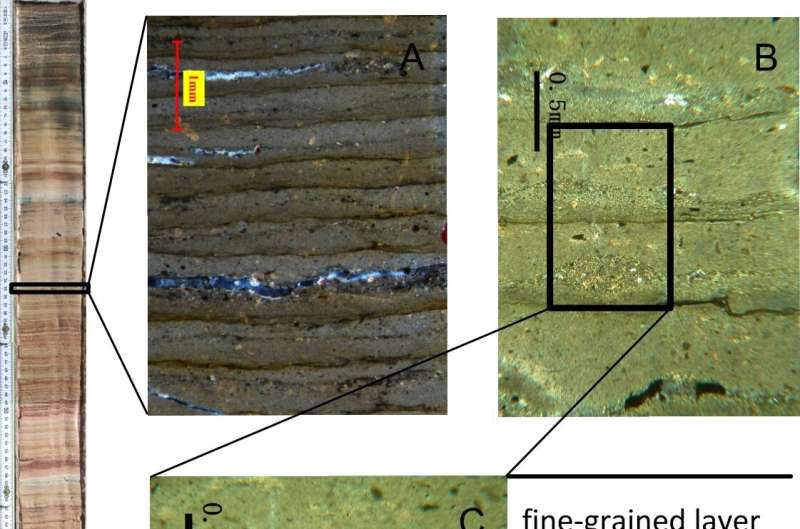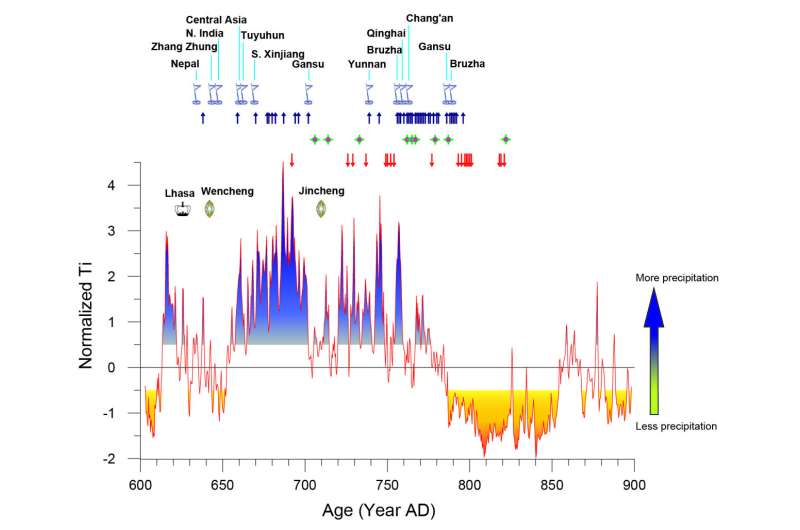This article has been reviewed according to Science X's editorial process and policies. Editors have highlighted the following attributes while ensuring the content's credibility:
fact-checked
trusted source
proofread
Climate change found to have fostered the rise and fall of the Tibetan Empire from 600 to 800 AD

Results are in from a study led by Dr. Juzhi Hou, Dr. Fahu Chen, and Dr. Kejia Ji (Group of Alpine Paleoecology and Human Adaptation (ALPHA), State Key Laboratory of Tibetan Plateau Earth System, Resources and Environment (TPESRE), Institute of Tibetan Plateau Research, Chinese Academy of Sciences).
The research team obtained a high-resolution climate record of the past 2,000 years using the varved sediments of Lake JiangCo on the central Tibetan Plateau. The warm and humid climate during the 7th-9th centuries AD and the subsequent cold and aridification are consistent with the rise and fall of the Tibetan Empire. Climate change is one of the possible reasons for the rise and fall of the Tibetan Empire.
During the preliminary field investigation, the researchers found that the varved sediment in JiangCo, a lake on the central Tibetan Plateau, was well-preserved. Through earlier varve counting and other radiometric dating methods, the time range of a gravity core of up to 1 meter covering the past 2,000 years was determined.
Subsequently, high-resolution XRF elements scanning and carbonate carbon/oxygen isotope analysis were performed on the sediment, and the temperature and precipitation records for the past 2000 years were reconstructed using biomarkers such as alkenones. The results showed that the 7th-9th centuries AD was an unusually warm and humid period.

The researchers compared this period with historical literature and found that it coincided with the only unified local regime, the Tibetan Empire, which existed on the Tibetan Plateau at that time. The changes in warm and humid climate and cold and dry climate were highly correlated with the foreign policy changes of the Tibetan Empire.
Combined with the ecological niche model, the researchers simulated the area of highland barley cultivation during the warm and humid period of the 7th-9th centuries AD and the subsequent cold and dry period, which differed by about 10.88 million hectares.
On the ecologically fragile environment of the Tibetan Plateau, climate change is one of the factors that constrains human activities. This latest research results show that warm and humid climates promote the development of agriculture and animal husbandry on the plateau, while cold and arid conditions have negative effects on agriculture and animal husbandry.
Climate change played a important role in the rise and fall of the Tibetan Empire. Today, with the warming and humidification of the Tibetan Plateau, studying the human-environment interactions in the past has important implications for modern responses to climate change.
The findings are published in the journal Science Bulletin.
More information: Juzhi Hou et al, Climate change fostered rise and fall of the Tibetan Empire during 600–800 AD, Science Bulletin (2023). DOI: 10.1016/j.scib.2023.04.040
Provided by Science China Press





















